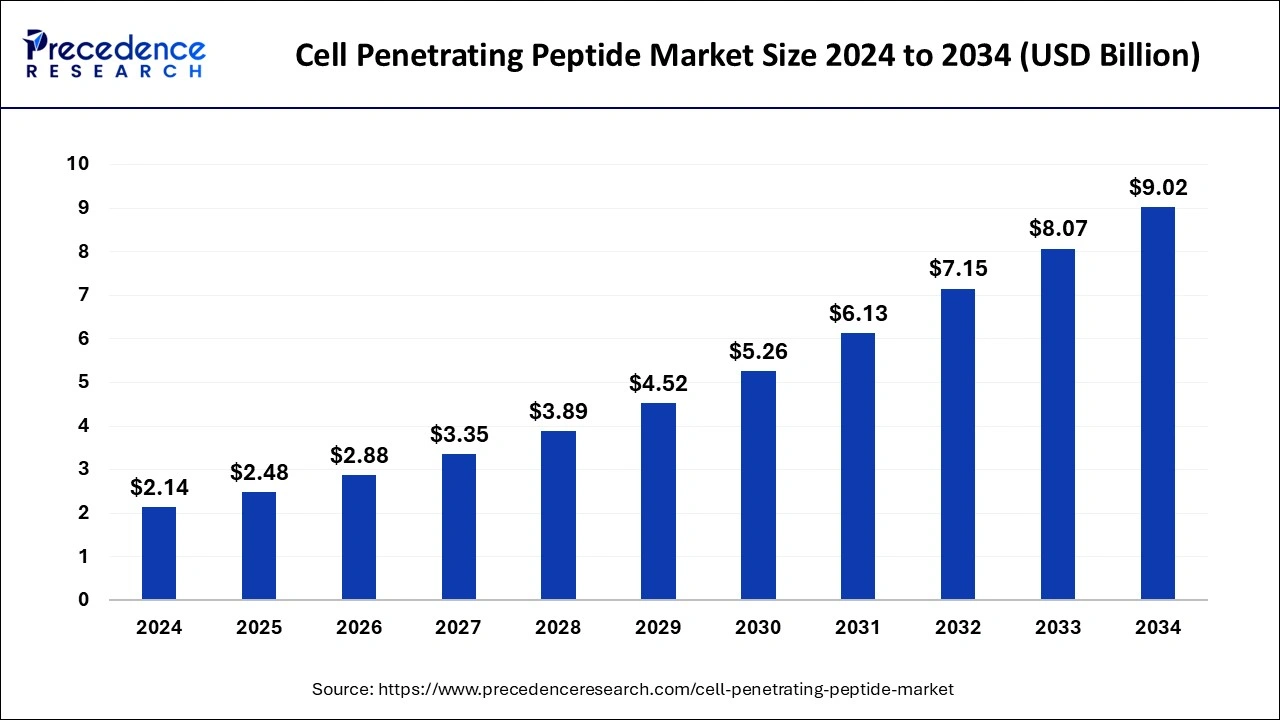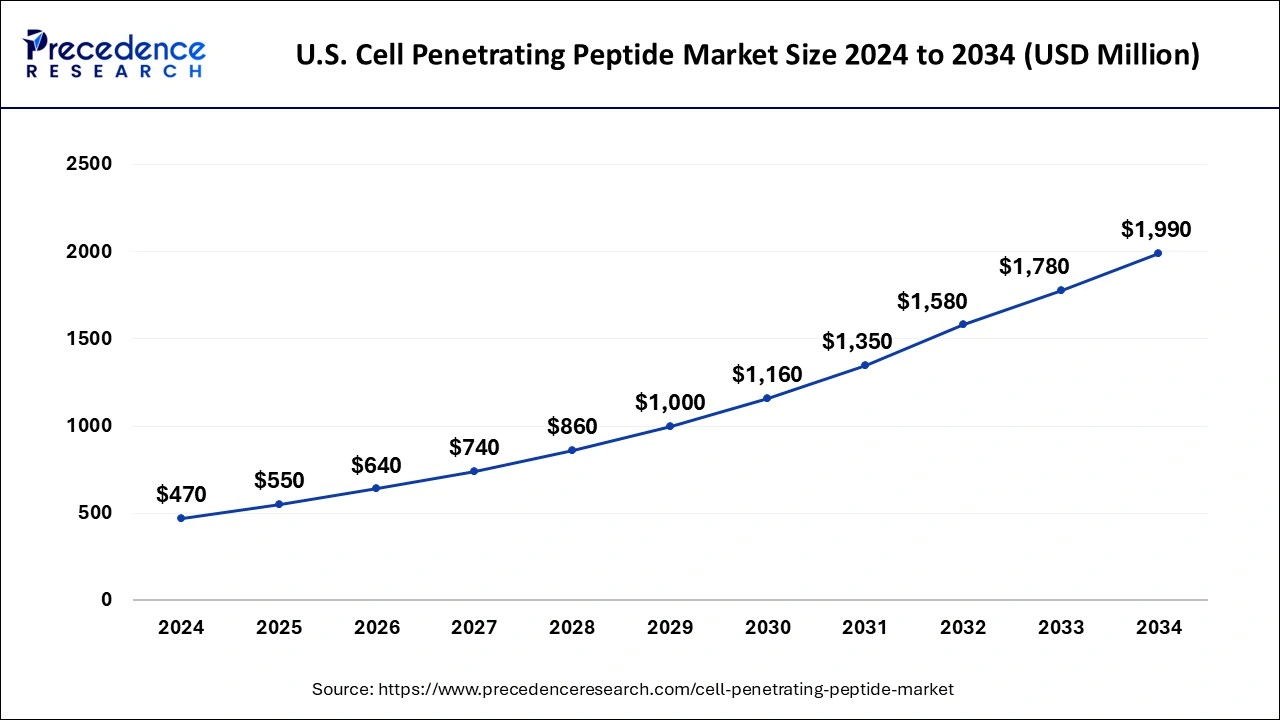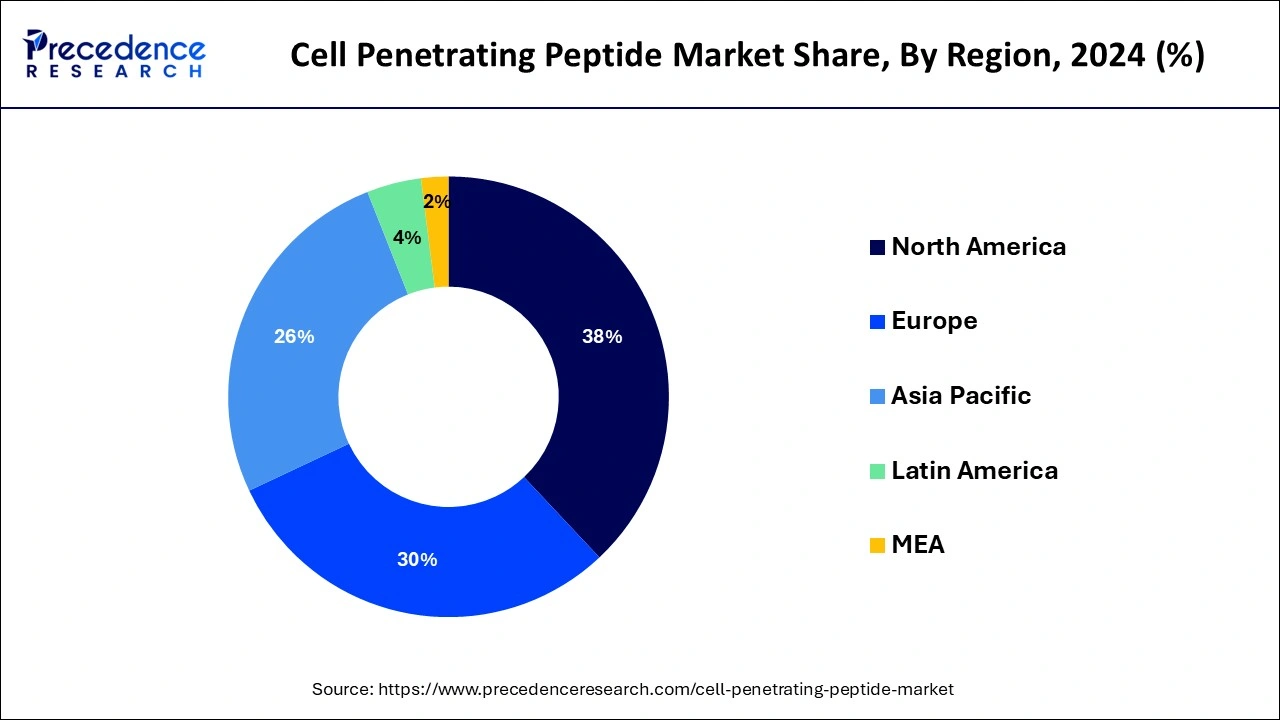February 2025
The global cell penetrating peptide market size is calculated at USD 2.48 billion in 2025 and is forecasted to reach around USD 9.02 billion by 2034, accelerating at a CAGR of 15.47% from 2025 to 2034. The North America market size surpassed USD 770 million in 2024 and is expanding at a CAGR of 15.49% during the forecast period. The market sizing and forecasts are revenue-based (USD Million/Billion), with 2024 as the base year.
The global cell penetrating peptide market size accounted for USD 2.14 billion in 2024 and is expected to exceed around USD 9.02 billion by 2034, growing at a CAGR of 15.47% from 2025 to 2034. The rising innovation in targeted drug delivery is driving growth of the cell-penetrating peptide market. The advancements in biotechnology are projected to further boost the market growth.

AI algorithms are able to predict the efficacy and toxicity of cell-penetrating peptides, which ultimately reduces the requirement of experimental trials. The ability of AI algorithms to detect potential CPPs and their interaction with cells is making them essential in the clinical trials. Additionally, the need for AI integration has been witnessed for tailored CPP designs and precision targeting to ensure the delivery of tissues and cells. With the help of AI, researchers are being able to provide personalized medicines as per each patient's requirements. Additionally, AI algorithms in gene therapies have also improved the target therapies and their diagnostics. AI not only helps researchers to understand the potential CPPs but also helps them to comply with regulatory requirements and complaints that need to be done by manufacturers.
The U.S. cell penetrating peptide market size was evaluated at USD 470 million in 2024 and is projected to be worth around USD 1,990 million by 2034, growing at a CAGR of 15.52% from 2025 to 2034.

North America has held the largest revenue share 38% in 2022. North America commands a significant share of the cell penetrating peptide (CPP) market due to a combination of factors. The region boasts advanced healthcare infrastructure, strong research and development capabilities, and a robust pharmaceutical industry. Additionally, a supportive regulatory environment and substantial investments in biotechnology and life sciences have propelled CPP-related research and innovation. The presence of key industry players, academic institutions, and collaborations further fuel market growth. Moreover, the region's growing focus on personalized medicine and gene therapy aligns well with CPP applications, cementing North America's leadership in this burgeoning market.

Asia-Pacific is estimated to observe the fastest expansion with the highest CAGR of 18.3% during the forecast period. Asia-Pacific has garnered significant growth in the cell penetrating peptide (CPP) market due to several factors. The region boasts a burgeoning biotechnology and pharmaceutical industry, fostering research and development in CPP-based therapies. Additionally, Asia-Pacific is a hub for contract manufacturing and research services, attracting global CPP-related projects. The region's vast population and rising healthcare needs provide a robust market for innovative drug delivery solutions, where CPPs play a pivotal role. This combination of industry growth, research capabilities, and a vast patient population positions Asia-Pacific as a major player in the CPP market.
The cell penetrating peptide (CPP) market is a burgeoning domain within the biotechnology and pharmaceutical sectors. CPPs, comprising short peptides, possess a distinctive capability to infiltrate cell membranes and facilitate the transport of therapeutic molecules and biomolecules. This novel class of peptides holds great potential for drug delivery, gene therapy, and molecular research.
The market is witnessing a surge in research and development endeavors aimed at leveraging CPPs for precise drug delivery, with a particular emphasis on enhancing therapeutic outcomes for a spectrum of conditions such as cancer and neurological disorders. The market is poised for significant expansion, driven by advancements in biotechnology and innovative therapeutic approaches.
| Report Coverage | Details |
| Market Size in 2025 | USD 2.48 Billion |
| Market Size by 2034 | USD 9.02 Billion |
| Growth Rate from 2025 to 2034 | CAGR of 15.47% |
| Largest Market | North America |
| Base Year | 2024 |
| Forecast Period | 2025 to 2034 |
| Segments Covered | Type, Application, End User, and Region |
| Regions Covered | North America, Europe, Asia-Pacific, Latin America, and Middle East & Africa |
Demand for targeted drug delivery
The cell penetrating peptide (CPP) market is experiencing robust growth, primarily fueled by the escalating demand for targeted drug delivery. This demand stems from the contemporary medical paradigm that seeks to deliver therapeutic agents precisely to the site of affliction while minimizing systemic exposure. CPPs have risen to prominence as a transformative solution in this context for various compelling reasons.
Firstly, the exceptional ability of CPPs to traverse cell membranes positions them as ideal carriers for ferrying drugs and therapeutic molecules directly into the desired target cells. This feature heightens the precision of drug delivery, mitigating the risks of off-target effects and collateral damage to healthy tissues.
Moreover, the surging emphasis on personalized medicine has accentuated the necessity for individualized treatments tailored to the genetic profile and distinct characteristics of each patient. CPPs empower the development of patient-specific therapies by facilitating the delivery of customized therapeutic agents to the precise cells or tissues necessitating intervention. Furthermore, as the pharmaceutical industry seeks more potent and less invasive treatment modalities, CPPs provide a versatile platform for optimizing drug administration. This, in turn, augments treatment efficacy, patient adherence, and overall therapeutic outcomes.
The burgeoning demand for targeted drug delivery, synergized with the exceptional attributes of CPPs, is propelling innovation and investments in this sector, making it a pivotal driver of growth in the CPP market. Consequently, the market is poised for substantial expansion, aligned with the continued evolution of precision medicine and personalized therapeutic approaches.
Restraints
Cargo selection and stability
The selection of cargo molecules and their stability represents a significant restraint on the growth of the cell-penetrating peptide (CPP) market. The choice of cargo to be delivered using CPPs is crucial in determining the success of therapeutic applications. Not all therapeutic agents or biomolecules are compatible with CPP-mediated delivery. Selecting appropriate cargos that maintain their integrity, activity, and stability during the delivery process is a complex challenge.
Additionally, the instability of certain cargo molecules during or after CPP-mediated delivery can limit the effectiveness of the therapy. This instability can result from various factors, such as enzymatic degradation, chemical reactions, or suboptimal intracellular conditions. Addressing these challenges necessitates careful cargo selection, the development of innovative cargo protection strategies, and the design of CPPs tailored to specific cargo requirements. Overcoming these limitations is essential to unlock the full potential of CPPs in drug delivery and related applications, which, in turn, will drive the market's growth by expanding its utility and efficacy.
Opportunities
Gene therapy advancements
The ever-evolving landscape of gene therapy is unfolding a wealth of opportunities in the cell penetrating peptide (CPP) market. Gene therapy, a pioneering approach to address genetic and acquired disorders, fundamentally relies on the efficient delivery of genetic material into targeted cells. In this critical arena, CPPs emerge as indispensable tools. CPPs play a pivotal role in the secure and efficient transportation of genetic cargo, encompassing DNA or RNA, through cell membranes, thereby facilitating gene therapy.
With the increasing acceptance and recognition of gene therapy in the medical realm, the demand for adept delivery systems like CPPs is soaring. This wave of opportunities emanates from multiple sources. First, the expansion of gene therapy applications into diverse disease domains, encompassing rare genetic maladies, oncology, and neurodegenerative disorders, is amplifying the call for CPPs. Second, as gene therapy methodologies continue to mature and showcase promising outcomes in clinical assessments, the utilization of CPPs in this context is poised for ascension. CPPs have the potential to elevate the precision and safety of genetic material delivery.
Third, collaborative efforts between gene therapy pioneers and experts in CPPs are likely to yield innovative solutions that enhance the efficacy of gene therapy treatments. In essence, the progress in gene therapy is opening up avenues in the CPP market by broadening the spectrum of gene-based interventions and refining the transport of genetic material, all in resonance with the burgeoning interest in personalized medicine and disease-specific therapeutic approaches.
According to the type, the protein-based cpps segment has held 55% revenue share in 2024. The segment of protein-based cell penetrating peptides (CPPs) commands a significant market share primarily due to its adaptability and dependability. These CPPs are crafted from natural proteins, endowing them with innate biocompatibility and a reduced likelihood of provoking unfavorable immune reactions. Their firmly established safety record and efficacy in transporting a broad spectrum of therapeutic cargo, including proteins and genetic material, position them as a favored option for researchers and pharmaceutical entities. Protein-based CPPs serve as a robust platform for crafting precision therapies, and their seamless integration with existing biopharmaceuticals and drug formulations cements their dominant standing within the market.
The peptide-based cpps segment is anticipated to expand at a significantly CAGR of 14.7% during the projected period. Peptide-based cell penetrating peptides (CPPs) hold significant growth in the market due to their inherent advantages. Peptides are highly biocompatible, offering reduced toxicity and immunogenicity concerns. Their diverse sequences can be tailored for specific applications, making them versatile for drug delivery and other molecular processes. Additionally, peptides can be easily modified for improved cellular uptake and cargo delivery. These attributes, coupled with established research and development efforts, have positioned peptide-based CPPs as a dominant segment within the cell penetrating peptide market, appealing to pharmaceutical and biotechnology industries for their innovative therapeutic potential.
In 2024, the gene delivery segment had the highest market share of 36% on the basis of the indication. The gene delivery segment holds a substantial share in the cell penetrating peptide (CPP) market due to its pivotal role in advancing gene therapy. CPPs have demonstrated their unique ability to efficiently transport genetic material into target cells, making them essential in the rapidly growing field of gene-based treatments.
This has led to increased demand for CPPs in various applications, including treating genetic disorders and cancer. As gene therapy gains recognition and acceptance, the Gene Delivery segment within the CPP market continues to expand, reflecting the increasing interest in precision medicine and innovative therapeutic approaches.
The molecular imaging segment is anticipated to expand at the fastest rate over the projected period. The molecular imaging segment commands a substantial growth in the cell penetrating peptide (CPP) market due to its critical role in non-invasive visualization of cellular processes. CPPs serve as invaluable tools for delivering contrast agents or imaging probes to specific cells or tissues, enabling real-time monitoring and diagnostics. This has found extensive applications in fields such as cancer detection, neuroimaging, and cardiovascular assessments. The precision and versatility of CPPs in molecular imaging have positioned them as indispensable components in diagnostics and research, driving their prominence growth within the broader CPP market.
In 2024, the pharmaceutical and biotechnology company segment had the highest market share of 49% on the basis of the end user. The dominance of the pharmaceutical and biotechnology company segment in the Cell Penetrating Peptide (CPP) market can be attributed to its central role in spearheading research, development, and the commercialization of CPP-based therapies. These firms possess the necessary resources, knowledge, and extensive infrastructure to conduct comprehensive preclinical and clinical investigations. They harness CPPs to revolutionize drug delivery, particularly in critical domains like precision oncology therapies and genetic interventions. This segment's commanding position arises from its capacity to translate scientific breakthroughs into practical, real-world applications, effectively bridging the divide between groundbreaking research and impactful clinical utilization, thus shaping the CPP market's trajectory.
The contract research organizations (cros) segment is anticipated to expand at the fastest rate over the projected period. Contract Research Organizations (CROs) hold substantial growth in the Cell Penetrating Peptide (CPP) market due to their pivotal role in research and development activities. CROs offer specialized expertise, infrastructure, and resources, making them attractive partners for CPP-related studies. Their involvement accelerates CPP research, aiding in custom CPP design, validation, and optimization. Furthermore, CROs streamline the testing of CPP-based therapies, ensuring safety and efficacy. Their contributions are integral in navigating the regulatory landscape and advancing CPP applications, making them a driving force behind CPP market growth.
By Type
By Application
By End User
By Geography
For inquiries regarding discounts, bulk purchases, or customization requests, please contact us at sales@precedenceresearch.com
No cookie-cutter, only authentic analysis – take the 1st step to become a Precedence Research client
February 2025
January 2025
January 2025
January 2025